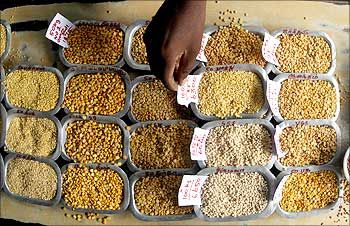 Lower output and inadequate policy are some of the reasons
Lower output and inadequate policy are some of the reasons
Price of pulses has once again started rising with chana trading at Rs 58 per kg in the wholesale market and tur dal set to touch Rs 200 per kg-level in the retail market.
Apart from lower crop in India and globally, thoughtless use of policy tools has contributed to the price rise.
Government agencies have created a buffer stock of 50,000 tonnes by procuring from farmers during the kharif marketing season 2015-16.
Also, import of 25,000 tonnes pulses was ordered.
The government is also initiating purchase of pulses with a target of procurement of 100,000 tonnes of chana and masoor.
These figures were announced by food and consumer affairs ministry last week.
However, for a country which has average consumption of 24 million tonnes a year, with 4 million tonnes imports, buffer of 50,000 tonnes is like a drop in the ocean.
Ashok Gulati former chairman of the Commission for Agricultural Costs and Prices said, “If the government wants to successful intervene in the pulses market, then at least two million tonnes of buffer stock should be built. Without having stock around 10 per cent of demand, it is difficult to have successive intervention.”
After imposing stringent stock limits on pulses, including for importers, government seized stocks, largely from Maharashtra.
It, however, didn’t have proper redistribution channels.
Now, government is also contracting imports.
So far, the government has released pulses largely for mid-day meal scheme and public distribution.
A Mumbai-based pulses trader and importer said, “Stock limits on pulses are proving counterproductive.
"Several importers have shifted to other ports on west and east coasts due to issues in Mumbai, which is a big market.
"This is because stock limits and cap time limits on offloading imported stock are difficult to comply with.”
He suggested a special committee, including representatives of industry, should be set up to handle pulses crisis.
According to trade estimates, India’s crop in this season would be only around 15-15.5 million tonnes, compared with usual 19-20 million tonnes.
This year, because of lower crop globally, pulses prices have shot up.
India Pulses and Grain Association estimates 2015-16 imports to be record-high 5.5 million tonnes.
Of this, 3.3 million tonnes was imported after October 15.
Bimal Kothari, vice-chairman, IPGA said, “There is need for a long term plan for pulses.
Government should encourage growing pulses in irrigated areas rather than rain-fed areas.
"India’s yield in pulses is lowest at 750 kg per acre, compared to global yield of 1,200-1,800 kg per acre in developed countries.
"This can be increased by developing high yield seed varieties.
"Also, government should enter market and buy pulses when harvest is on.”
Traders also say that the government might be importing but trade had developed a distribution channel which was more robust than that of the state agencies.
Pulses contain 30 per cent protein and hence are among the most-needed food items.
Gulati suggests that government should promote use of soybean which has higher protein content than pulses.
“Food technologies have improved significantly and soybean flour can be reconstituted in dal and mixed with pulses.
"Even for mid-day meal, this is ideal,” said Gulati.
“Tofu is another soybean product that should be promoted. Food technologies have been there to develop tests for soya products which can be easily substituted for pulses as protein-rich diet,” he suggested.
Kothari believes that Pulses Mission, which has been around for long, should be strengthened to improve acreage and increase yield.
The image is used for representational purpose only. Photograph: Reuters












 © 2025
© 2025